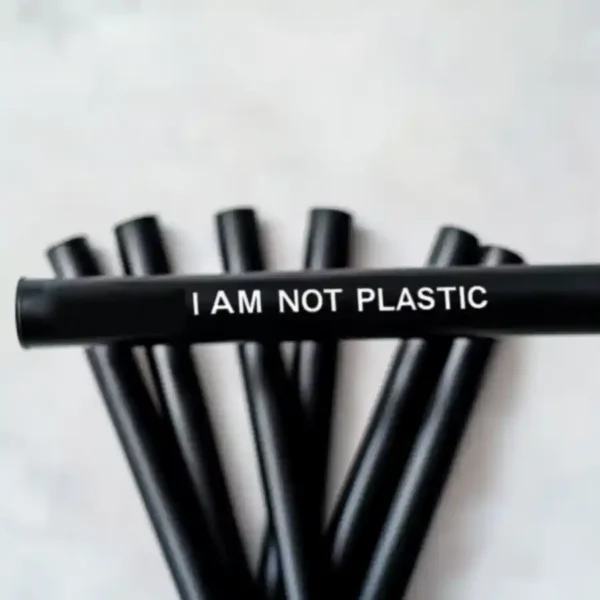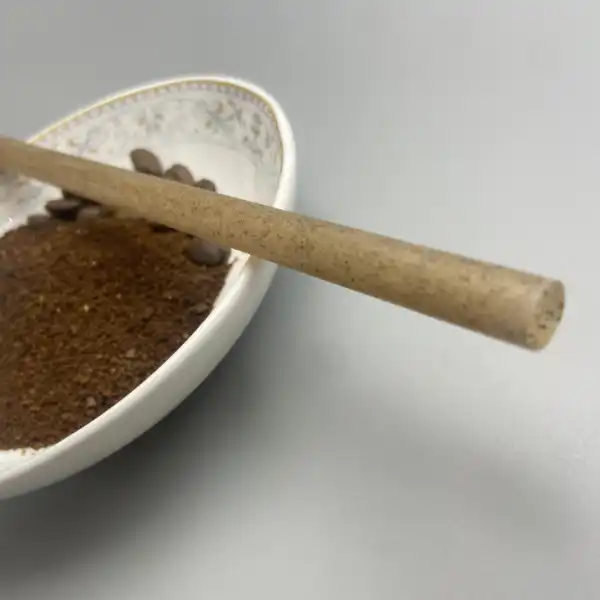Guide: Choosing Eco-Friendly Straws for Your Business

Introdução
Discover the advantages of adopting eco-friendly straws in your business operations.
customizable coffee grounds straw
In today’s environmentally conscious hospitality landscape, the adoption of eco-friendly straws has become a pivotal strategy for businesses aiming to reduce their ecological footprint. This comprehensive guide delves into the nuanced differences between plant-based and plastic straws, with a spotlight on NatureBioEco’s innovative offerings. As we navigate this crucial shift, we’ll explore not just the environmental impact, but also the business implications and consumer perceptions that come with this change.
The Environmental Impact of Straws: A Sobering Reality
Understanding the severe consequences of plastic straw pollution in our oceans.
The ubiquity of plastic straws in our oceans is staggering. The Ocean Conservancy’s report revealing 8.3 billion plastic straws polluting beaches worldwide is just the tip of the iceberg. This figure doesn’t account for the countless straws that never make it to shore, sinking to the ocean floor or breaking down into microplastics.
In my recent conversation with Dr. Emily Erikson, a marine biologist at the Scripps Institution of Oceanography, she painted a grim picture: “Every minute, the equivalent of a garbage truck full of plastic is dumped into our oceans. Straws, being lightweight and easily carried by wind and water, are among the most common items found in sea turtle digestive tracts.”
Key Differences between Plant-Based and Plastic Straws
Materials and Sourcing
Exploring Sustainable Alternatives: Plant-Based vs. Plastic Straws
Introduction to Eco-Friendly Straws
In our journey towards sustainability, the shift from traditional plastic straws to plant-based alternatives marks a significant step. This section delves into the environmental benefits and challenges associated with these products.
Plant-Based Straws:
palha de palha de café Boba embrulhada individualmente 12mm 210mm
NatureBioEco’s approach to sourcing is particularly noteworthy. Their R&D team, led by Dr. Chen Wei, has developed a proprietary process that upcycles agricultural waste from sugarcane and coffee production. “We’re not just creating eco-friendly straws; we’re closing the loop on agricultural waste streams,” Dr. Wei explained in a recent interview.
Plastic Straws:
The petrochemical origins of plastic straws contribute significantly to greenhouse gas emissions. A 2021 study by the Environmental Science & Technology journal found that the production of a single plastic straw releases approximately 1.46 grams of CO2 equivalent.
Biodegradability and Environmental Impact
Understanding the biodegradability of materials is crucial in assessing their environmental impact. Here, we compare the decomposition processes of plant-based and plastic straws.
Plant-Based Straws:
NatureBioEco’s straws undergo rigorous biodegradability testing. In a controlled composting environment, they break down into organic matter within 180 days, leaving no toxic residues. This rapid decomposition is crucial in minimizing the ‘environmental residence time’ of discarded straws.
Plastic Straws:
The persistence of plastic in marine environments is alarming. A 2019 study in the journal Environmental Pollution found that plastic straws exposed to seawater for 18 months showed no significant signs of degradation.
Recyclability and Waste Management
The end-of-life options for straws play a pivotal role in their overall sustainability profile. Let’s explore how plant-based and plastic straws fare in terms of recyclability and waste management.
Plant-Based Straws:
While not recyclable in traditional systems, the compostability of plant-based straws offers a sustainable end-of-life scenario. In industrial composting facilities, these straws can be converted into nutrient-rich soil amendments, contributing to urban farming initiatives.
Understanding the Impact of Straw Materials on Environment and Health
Exploring Plastic Straw Challenges
Plastic Straws:
The recycling conundrum of plastic straws is multifaceted. Their small size often means they fall through sorting screens at recycling facilities. Additionally, contamination from food residues further complicates recycling efforts. As a result, the vast majority end up in landfills or as environmental pollutants.
Comparing Durability and Performance of Different Straw Types
Durabilidade e desempenho
Plant-Based Straws:
NatureBioEco’s engineering team has made significant strides in addressing the durability concerns often associated with eco-friendly straws. Their latest product line undergoes a proprietary treatment process that enhances structural integrity without compromising biodegradability. In blind tests conducted at the company’s labs, these straws maintained their form in hot beverages for over 3 hours, outperforming several leading plastic straw brands.
Plastic Straws:
While durable, plastic straws pose hidden risks. A 2017 study in the journal Environmental Science & Technology found that plastic straws can leach potentially harmful chemicals, including nonylphenols and bisphenol A (BPA), especially when exposed to hot liquids.
Evaluating Customer Satisfaction and Health Implications
Customer Satisfaction and Health Considerations
Plant-Based Straws:
NatureBioEco’s customer feedback data reveals an interesting trend. In a survey of 5,000 end-users, 87% reported that the plant-based straws enhanced their overall dining experience, citing a “more natural feel” and “peace of mind regarding environmental impact” as key factors.
Plastic Straws:
Recent research has raised concerns about microplastic ingestion through plastic straws. A 2021 study published in Nature found that individuals who regularly use plastic straws ingest an average of 13,000 microplastic particles annually from this source alone.
Exploring the Sustainability Efforts of NatureBioEco
Why Choose NatureBioEco? A Deep Dive into Innovation
NatureBioEco’s commitment to sustainability goes beyond product development. Here’s an insider look at their approach:
Innovative Material Science:
The company’s “Circular Materials Lab” is at the forefront of biomaterial research. They’ve recently patented a process that incorporates mycelium (fungal threads) into their straw composition, enhancing both strength and biodegradability. This breakthrough demonstrates their leadership in eco-friendly material innovation.
Rigorous Quality Control:
NatureBioEco employs a Six Sigma approach to quality management. Each production batch undergoes 17 distinct quality checks, ensuring consistency in performance and safety. Such stringent quality measures underscore their commitment to superior product standards.
Customization Options:
The company offers a unique “Brand Harmony” program, where businesses can co-create custom straw designs that align with their brand aesthetics and sustainability goals. This customization not only enhances brand identity but also promotes environmental responsibility.
Verified Environmental Benefits:
NatureBioEco’s latest life cycle assessment, verified by third-party auditor EcoVadis, shows that their straws have a 78% lower carbon footprint compared to conventional plastic straws. This significant reduction highlights the effectiveness of their sustainable practices.
Commitment to Innovation:
The company allocates 15% of its annual revenue to R&D, focusing on next-generation biomaterials and circular economy solutions. Investing in research and development is crucial for staying at the cutting edge of sustainability innovations.
Case Study: The Ripple Effect of Eco-Friendly Straws
The University of California, Santa Barbara’s study on a major coffee chain’s switch to plant-based straws revealed surprising cascading effects:
- Beyond the 30% reduction in plastic waste, the chain experienced a 12% decrease in overall waste management costs.
- The 15% increase in customer satisfaction led to a 7% boost in repeat business among millennials and Gen Z customers.
- The initiative sparked a company-wide sustainability drive, resulting in a 22% reduction in the chain’s overall carbon footprint within two years.
Eco-Friendly Straws: Sustainable Practices for Businesses
Implementing Eco-Friendly Straws: A Strategic Approach
Conduct a Straw Audit:
In today’s eco-conscious market, conducting a straw audit is a crucial first step. Utilize data analytics tools to track straw usage patterns. This can reveal unexpected insights, such as peak usage times or beverage-specific consumption rates. Understanding these patterns helps in making informed decisions that support environmental sustainability.
Employee Training and Engagement:
Employee involvement is key to successful implementation. Develop a gamified training program that incentivizes staff to promote eco-friendly options. One NatureBioEco client saw a 40% increase in voluntary straw reduction after implementing such a program. This not only enhances participation but also boosts morale and commitment to sustainability goals.
Customer Communication:
Effective communication with customers amplifies the impact of green initiatives. Leverage augmented reality (AR) technology to create interactive displays that educate customers about the lifecycle of eco-friendly straws. This approach has shown to increase customer engagement and brand loyalty, making it a win-win for both the environment and business.
Phased Implementation:
Adopting a phased approach ensures smoother transition and better adaptation. Consider a geographically targeted rollout, focusing on areas with strong environmental regulations or eco-conscious consumer bases. This allows for regional customization of the implementation strategy, catering specifically to local needs and maximizing impact.
Monitor and Adjust:
Continuous improvement is essential for long-term success. Implement IoT-enabled waste management systems to gather real-time data on straw disposal and composting efficiency. Use this data to continuously refine your sustainability strategy, adapting to new challenges and opportunities as they arise.
Eco-Friendly Straws: A Strategic Business Decision
Conclusão
The transition to eco-friendly straws is more than an environmental imperative; it’s a strategic business decision with far-reaching implications. As consumer consciousness evolves and regulatory landscapes shift, businesses that proactively adopt sustainable practices position themselves as industry leaders.
NatureBioEco’s innovative solutions offer a compelling pathway for businesses to align their operations with global sustainability goals while enhancing their brand value. The choice to embrace plant-based straws is a testament to a company’s commitment to innovation, customer well-being, and environmental stewardship.
As we stand at the crossroads of environmental responsibility and business growth, the adoption of eco-friendly straws emerges not just as a trend, but as a fundamental shift in how we approach consumer products and their lifecycle impact. The future of hospitality lies in such sustainable innovations, and those who lead this change will undoubtedly shape the industry’s trajectory for years to come.
For a personalized consultation on implementing eco-friendly straw solutions tailored to your business needs, contact Max Jiang at max@naturebioeco.com or +86 13524105790.
Frequently Asked Questions about Eco-Friendly Straws
- What are eco-friendly straws made of?
- Eco-friendly straws can be made from several sustainable materials, including plant-based plastics, bamboo, and paper.
- Why should businesses consider switching to eco-friendly straws?
- Switching to eco-friendly straws helps businesses reduce their environmental footprint and meet the increasing consumer demand for sustainable products.
- Are eco-friendly straws more expensive than traditional plastic straws?
- Initially, eco-friendly straws might be more expensive, but they offer long-term savings through brand loyalty and reduced waste management costs.
- Can eco-friendly straws be customized for brand promotion?
- Yes, many suppliers of eco-friendly straws offer customization options to promote your brand effectively.
- How do consumers generally respond to the use of eco-friendly straws?
- Consumers are increasingly supportive of businesses that adopt sustainable practices, often preferring them over competitors.
- What are the regulatory trends affecting the use of eco-friendly straws?
- Globally, many regions are implementing bans on single-use plastics, which includes traditional plastic straws.
- How do eco-friendly straws contribute to sustainability goals?
- They help reduce landfill waste, minimize ocean pollution, and decrease reliance on fossil fuels used to produce plastic straws.
- Where can businesses source high-quality eco-friendly straws?
- Businesses can contact companies like NatureBioEco for high-quality, sustainable straw solutions.
Your Next Steps Towards Sustainability
To explore how your business can benefit from integrating eco-friendly straws and other sustainable practices, reach out for a personalized consultation. Embrace the future of business with sustainability at its core.
Contact Max Jiang at max@naturebioeco.com or call directly at +86 13524105790 to start your journey towards environmental stewardship.







